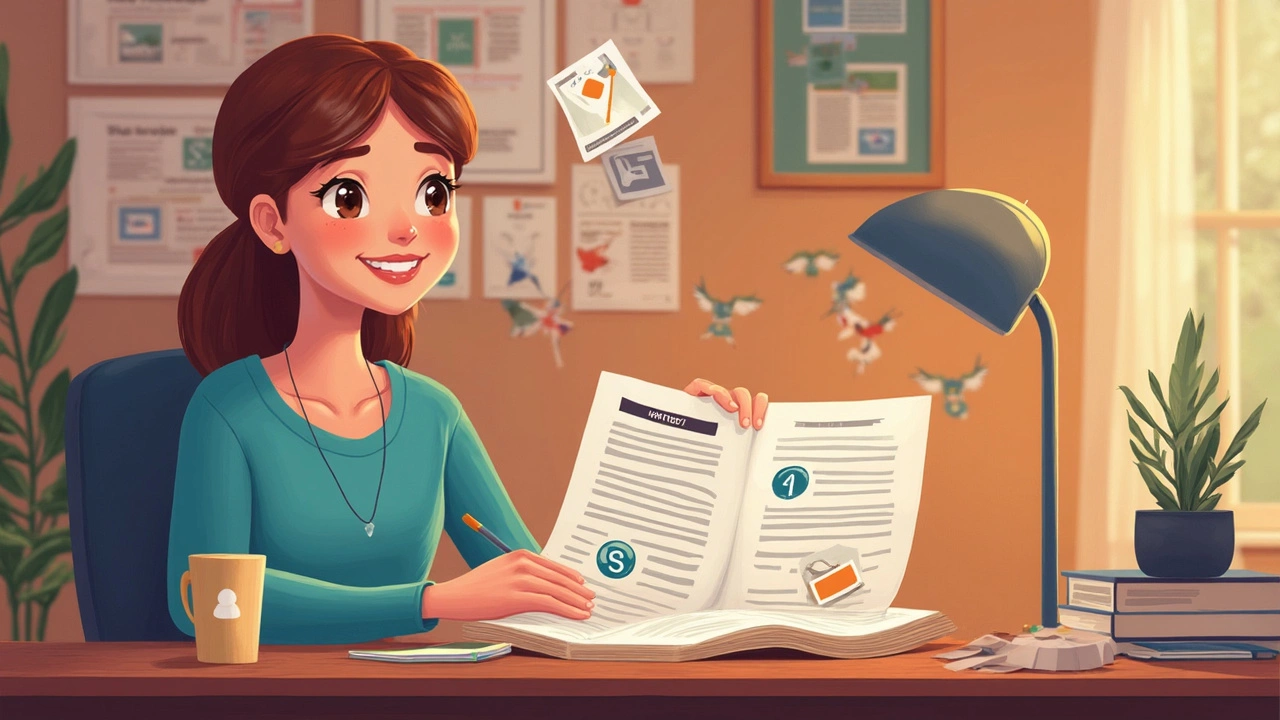Think you can use anything you find on Canva however you want? Not so fast. Lots of people make this mistake—sometimes it leads to awkward emails from copyright holders or even legal trouble.
When you’re working on posters, online ads, or digital art, it can be tempting to grab that cool background or font without a second thought. But not everything on Canva is as “free” as it looks. Some parts are okay for personal use, some stuff is fine for business, but others? You might not be allowed to use them at all for selling or mass distribution.
Understanding these rules isn’t as boring as it sounds—it can actually save you from a ton of problems later. Stick with me and you’ll figure out how to spot what’s safe to use, what’s a red flag, and the easiest ways to avoid accidentally breaking the rules on Canva.
- What Does 'Copyright Free' Mean, Really?
- Canva’s Content: Free, Pro, and Licensed Material
- What You Can and Can’t Do With Canva Designs
- Tips to Use Canva Without Legal Trouble
What Does 'Copyright Free' Mean, Really?
People toss around “copyright free” like it means you can do whatever you want, but that’s not totally true. Just because something is marked as free doesn’t mean all the rights are yours. In fact, most Canva stuff comes with some rules.
Let’s break it down. Copyright means the creator owns the work, whether it's a photo, music, design, or illustration. If you want to use their work, you usually need permission. Some creators give that permission by releasing work into something called the public domain—here, anyone can use it for anything, no strings attached. Others use licenses like Creative Commons, which have special terms (like 'credit me' or ‘don’t sell this’).
When people say “copyright free,” there’s a lot of confusion. Technically, true copyright-free stuff is public domain—no rights attached, no restrictions. But a ton of material out there is “free to use” or “royalty-free.” That’s not the same thing. 'Free to use' just means you don’t pay, but there still might be limits on how and where you use it. 'Royalty-free' lets you use it after paying once (or as part of a subscription) but doesn't mean it’s free from all restrictions.
Here’s a look at the different types of usage rights you might bump into:
- Public Domain: Zero restrictions. Do whatever you want.
- Creative Commons (CC): Some permissions given, but check the fine print. Sometimes you have to give credit, sometimes you can’t use for business, etc.
- Royalty-Free: Pay once (maybe through a subscription like Canva's Pro), use many times, but usually can’t resell the file or make a logo out of it.
- Rights Managed: Have to buy a license for each use. Not common on Canva, but you’ll see it if you buy photos elsewhere.
Check out this quick reference to see what the terms usually mean:
| Term | Can You Use for Business? | Can You Sell It? | Must Give Credit? |
|---|---|---|---|
| Public Domain | Yes | Yes | No |
| Creative Commons | Sometimes | Sometimes | Usually |
| Royalty-Free | Yes (often) | No (as-is) | No |
| Rights Managed | Depends on license | Depends on license | Maybe |
If you found something on Canva and want to use it for your brand or sell it, don't assume 'copyright free' means you’re in the clear. Always check the details for each element—Canva is clear about what’s covered and what’s not (you just have to read their licensing info).
Canva’s Content: Free, Pro, and Licensed Material
Here’s where things get real. Not every photo, graphic, or music track you see on Canva is just up for grabs. Canva breaks its stuff into three main categories: Free, Pro, and Licensed content. Knowing which is which makes a big difference, especially if you’re planning to use your design for work, products, or anything public.
Canva marks most of its content pretty clearly. You'll see “Free” tags on stuff like basic photos, elements, fonts, and backgrounds—that means no added charge, but it doesn’t always mean you can use it for anything without limits. Next up: “Pro” items. These are available to paying Canva Pro subscribers or if you buy them individually. Just paying doesn’t mean you own the image forever or can use it for whatever you want. There are still some rules.
Then there’s Licensed material—this is the trickiest. Canva has deals with outside companies and photographers, and the permissions on these can get strict. For example, some stock photos come from Getty or Pixabay, and while you can put them in your designs, you can’t just resell the image, upload it to another stock site, or claim it as your original work.
| Type | Free for Everyone? | Use in Commercial Projects? | Extra Restrictions? |
|---|---|---|---|
| Free Content | Yes | Usually Yes | Can’t resell as-is |
| Pro Content | No (Pro Plan needed) | Yes (with license) | No standalone resale, no redistribution |
| Licensed/Stock | Sometimes | Sometimes | Varies by provider, check the license info |
Easy ways to spot which is which? Look for the small crown icon on a thumbnail—that’s Pro. Also, Canva usually pops up a prompt to pay if you’re dragging a paid item onto your design from a free account. For licensed material, click on the “i” (info) button to see where it came from and if there are special terms.
If you’re planning to print on T-shirts, sell templates, or publish your designs anywhere that earns you money, double-check the license. For instance, Canva’s “One Design Use License” (for one-off projects) covers a single end product. The “Multi-Use License” lets you use that same image in multiple projects, but it’s pricier and less common. Don’t assume you’re covered just because you downloaded an image from Canva.
If you’re ever in doubt, Canva’s own Content License Agreement is worth a quick skim—it’s surprisingly clear (for legal stuff). And just to make sure you’re using content legally, it’s smarter to use original images, or rely on Canva’s free and Pro libraries for most needs.

What You Can and Can’t Do With Canva Designs
This is the part that trips people up the most. Just because you made something cool on Canva doesn’t mean you can do whatever you want with it. Canva splits things up into three main groups: free stuff, Pro elements, and licensed images from outside sources. Each has its own rules.
Let’s clear up what you can and can’t do:
- Canva Free Content: You can use these for personal projects, business social posts, and a lot of commercial work, like printing flyers or making a logo for your bakery. But you can’t just download an image (say, a photo or icon) and sell it as is on a t-shirt. You’ve got to make the design your own—that means mixing things up and adding your own touch.
- Pro and Paid Elements: When you use paid designs or elements, you’re basically renting them. The Pro license lets you use them in commercial projects—like ads or products you sell—if you’re sticking to Canva’s license terms. You can’t redistribute them as stand-alone files.
- Stock Photos and Licensed Images: Some content comes from places like Pexels or Pixabay, but even then, usage is limited. For example, you may not be able to trademark a logo if it’s just a Canva image with nothing else done to it.
Don’t forget about templates. It might look easy to resell Canva’s ready-made templates on Etsy or your own website, but that’s actually against Canva’s rules. If you want to sell templates, they have to be your original work, made from scratch using Canva tools.
Here's a quick way to check what’s cool and what isn’t:
| Action | Allowed? | Notes |
|---|---|---|
| Making a business card for yourself | Yes | Customize it, you’re all set |
| Downloading a stock photo and selling as a poster | No | Needs significant changes, not just the photo alone |
| Using Canva icons in your app design | Yes | As part of a larger design |
| Uploading a Canva template to Etsy to resell | No | Unless you’ve created it 100% on your own, not allowed |
| Marking a Canva logo as your trademark | Depends | Can’t use stock-only images or elements for trademarks |
Another thing: sharing a Canva design file directly with someone is fine if you’re working together (think group projects or a business team). But posting downloadable links or files for mass use or resale is off-limits. If you ever feel unsure, check Canva’s content license page—they update it regularly, making it clear what you can and can’t do. Better safe than sorry when it comes to copyright headaches.
Tips to Use Canva Without Legal Trouble
If you want to keep your designs safe, you need to pay attention to Canva’s licensing details. Just clicking 'download' doesn’t mean you own unlimited rights. Here are some must-know facts and steps you can follow to avoid copyright headaches:
- Check the license type every time. When you pick images, videos, or graphics on Canva, a little info window lets you see if it’s 'Free', 'Pro', or requires a different license. This matters even if you have a Canva Pro account. The rules change based on your use—personal, business, or commercial.
- Remember, Canva’s 'One Design Use License' often means you can’t use a paid element in more than one design unless you pay again. That tripped up lots of creators who tried to reuse something for multiple products.
- If you want to sell something, double-check commercial rights. Using Canva fonts, basic shapes, or free elements in items you sell (like t-shirts or prints) is usually fine, but using photos of celebs, specific stock images, or logos is not. Canva’s help docs clearly say you can’t use their platform for trademarked or copyrighted content that isn’t covered by the license.
- Don’t use Canva for logos if you want to trademark that logo. Canva’s own FAQ admits that their icons, stock graphics, and fonts can’t form the core of a trademarked brand because of shared rights. If you want something unique, design it from scratch or hire an artist.
- Always give proper credit if Canva tells you to. Some elements have extra requirements. You’ll usually see a note when you download—ignore it and you could lose your access or face DMCA complaints.
It pays to know the differences:
| Content Type | Personal Use | Commercial Use | Limitations |
|---|---|---|---|
| Free Images/Graphics | Yes | Yes | No standalone redistribution, attribution needed rarely |
| Pro Images/Elements | Yes (with subscription) | Yes (with subscription) | No use for logos, one design per license |
| Stock Videos/Music | Yes | Depends on license | No redistribution by themselves |
Here’s a quick checklist before you share or sell anything made with Canva:
- Review Canva’s legal page and check the license before downloading.
- Make sure you’re not using their elements as your business logo or selling them unchanged.
- If making merch, avoid using Canva stock photos of actual products, places, or people.
- Always keep proof of your project’s license and source—screenshots help if you ever get questioned later.
You don’t have to memorize all the fine print. But if you pause and check what a Canva element’s license actually allows, you’ll stay out of trouble—and you’ll look more pro at the same time.

